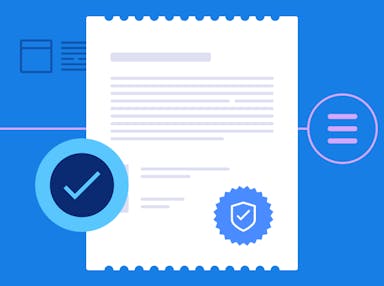
Mobile Device Management (MDM) Software & Its Role in a Security Compliance Program
Anna Fitzgerald
Senior Content Marketing Manager
Rob Gutierrez
Senior Cybersecurity and Compliance Manager, CISA, CCSK, CMMC RP
Cyber attacks against mobile devices are on the rise, according to new research by Zimperium.
And it’s not just that organizations are encountering more mobile-related breaches — these types of breaches are also having a bigger impact. In Zimperium’s 2023 Global Mobile Threat Report, 73% of organizations that experienced a mobile-related compromise described it as a “major” breach.
Managing these devices can help reduce your attack surface and protect your organization. Let’s dive into the importance of mobile device management and software below.
What is mobile device management?
Mobile device management (MDM) refers to the process of managing, securing, and monitoring mobile devices used within an organization to access enterprise assets. It encompasses a range of tasks, including:
- device configuration
- application management
- compliance enforcement with organizational policies
MDM involves a combination of software, processes, and policies designed to reduce the risk of enterprise mobile devices being hacked, stolen, or lost in order to protect critical business data. Let’s take a closer look at the importance of MDM below.

Why mobile device management is important
Smartphone adoption has been steadily increasing across the globe, and is expected to continue to in the next few years. By 2030, most regions are expected to see adoption rates increase above 90%.
More people are using smartphones and other mobile devices to communicate, shop, bank, navigate, take photos, work, and more. In fact, Zimperium’s 2022 report revealed that 60% of the endpoints accessing enterprise assets were mobile devices.
As mobile device use continues to increase in the workplace, so do organizations’ attack surfaces. They must take steps to reduce this attack surface to avoid operational disruptions, data breaches, and regulatory compliance risks.
MDM addresses these concerns by providing centralized control over mobile devices, ensuring they are properly provisioned, configured, secure, and compliant with organizational policies. This helps organizations manage devices and users in a consistent, scalable way.
Recommended reading

Regulatory Compliance: Benefits and Best Practices to Keep Your Business Safe [+ Checklist]
Mobile device management and security
MDM can help strengthen the security and privacy of your enterprise environment.
MDM typically involves on or multiple tools that offer a range of protection capabilities that can enable organizations to:
- Configure settings like disk encryption
- Enforce strong authentication measures and passwords
- Automate patch management
- Roll out anti-virus solutions
- Enforce software updates
- Encrypt data
- Detect and report high-risk or non-compliant devices
- Remotely lock or wipe lost or stolen devices
These tools help improve the security of enterprise devices, ensure compliance with organizational policies and framework requirements, and reduce adverse effects if a device is compromised.
Recommended Reading

How to Get Started with IT Asset Inventory Management
How mobile device management works
MDM operates using endpoint software installed on mobile devices (typically known as agent software) and a server that has a centralized management console accessible to administrators.
The agent software communicates with the MDM server, allowing administrators to remotely configure, monitor, and manage devices across the organization.
What is mobile device management software?
Mobile device management software refers to the technology solutions used to implement and manage MDM policies and controls.
While these solutions vary in features, scalability, and deployment options, they do typically have a core set of features and functionalities designed to streamline device management and enhance security. These include:
- Device enrollment and provisioning: Simplifying the process of onboarding new devices into the organization's network.
- Configuration management: Ensuring that devices are configured according to organizational policies and standards.
- Application management: Controlling which applications can be installed and used on corporate devices.
- Data protection: Implementing measures such as encryption and remote wipe to safeguard sensitive data.
- Compliance enforcement: Ensuring that devices adhere to regulatory requirements and organizational policies.
Recommended reading

How to Create a Configuration Management Plan & Why It’s Important [+ Template]
Tips for evaluating and deploying MDM software
Use the tips below to enhance the process of evaluating and deploying MDM software.
1. See if your compliance automation tool has MDM functionality or integrations
Device management is necessary to comply with SOC 2® and many other frameworks. As a result, some compliance automation platforms offer agent software. This can be a good option for smaller companies (around 50 employees) not ready to implement an MDM, or for larger companies that need time to evaluate vendors but still need to prove to auditors that they have appropriate controls in place.
However, for companies that are ready to use an MDM to simplify and enhance their ability to manage end-user devices like laptops and smartphones, consider using a solution that integrates with your compliance automation platform. That way, information about devices in your MDM instance can be pulled into the platform to inform your security controls and simplify audit prep for SOC 2, ISO 27001, HIPAA, and other frameworks.
2. Deploy MDM software as early as possible
Deploying an MDM solution requires planning and budget, but doing it as soon as possible can help simplify device management. Since switching to an MDM requires manual effort and commitment from internal experts or third-party professional services, it’s easier to make the switch when you have a smaller number of employees and devices.
3. Use evaluation criteria for MDM software
You want an MDM solution that will save time, improve efficiency, and increase security. Consider compiling some criteria to help you choose the best solution for your unique needs and goals. Some common core features are:
- Device security capabilities: The main purpose of an MDM solution is to protect enterprise mobile devices, so MDM providers need to provide adequate device security measures like data encryption, security configuration, and access monitoring.
- Automated reports: An MDM tool may consolidate all enrolled devices and associated information into easy-to-follow reports that are updated automatically without manual input.
- Easy search: An MDM tool should have powerful search functionality so you can easily and quickly access your devices, integrations, reports, apps, and secure documents.
4. Understand what resources you’ll need
You’ll need to allocate resources to successfully deploy an MDM solution. So before going through the procurement process, consider your requirements and resources. Whether you have the internal expertise for this project or will need to use external professional services is one of the most important decisions.
Also, an MDM solution requires continuous management so ensure you have dedicated resourcing available beyond deployment.
5. Be transparent and communicative
To make MDM deployment as smooth as possible, it’s important to provide transparent communications and documentation to ensure users and admins understand what’s happening and when, why it’s important, and what time and actions are required of them. Consider getting executive-buy in, telling managers how much time they’ll be asking of their teams, holding office hours, and announcing MDM updates during all-hands.
Documentation that offers step-by-step instructions can also make deployment easier.
How Secureframe can help simplify mobile device management
With Secureframe, organizations can effectively manage their mobile devices, enhance security, and ensure compliance with ease.
Secureframe offers the Secureframe Agent as a free, read-only alternative for organizations that aren’t ready to implement a third-party MDM solution. This agent is quick to install on employee devices and simplifies compliance requirements like encryption, data backups, application and software updates. It can also quickly generate reports for your auditor, speeding up the compliance process.
For organizations that are ready to implement a third-party MDM solution, Secureframe integrates with some of the most popular solutions including Kandji, JAMF, Hexnode, Microsoft Intune, and more. You can check out the full list here.
If you’re interested in learning more about how Secureframe’s agent and/or MDM integrations can help simplify compliance, book a demo with one of our experts.
FAQs
Is MDM only suitable for large enterprises?
No, MDM solutions can be tailored to meet the needs of organizations of all sizes, from small businesses to large enterprises.
Can MDM be used to monitor employee activity on mobile devices?
While MDM solutions can track device usage and application activity, it's important to balance employee privacy with security and compliance requirements.
How does MDM help with regulatory compliance?
MDM enables organizations to enforce security policies and controls, encrypt sensitive data, and track device usage, helping them comply with regulatory requirements such as GDPR, HIPAA, and PCI DSS.
Is an MDM required to be SOC 2, ISO 27001, or HIPAA compliant?
Implementing an MDM solution is not a hard requirement for SOC 2, ISO 27001, or HIPAA, but each framework has related endpoint requirements and an MDM does make it much easier to monitor, control, and enforce compliance with those requirements.
Are different MDMs better for different types of devices?
Yes, Kandji is known to be great for Apple devices whereas a Microsoft-heavy team might want to implement Microsoft Intune.

Anna Fitzgerald
Senior Content Marketing Manager
Anna Fitzgerald is a digital and product marketing professional with nearly a decade of experience delivering high-quality content across highly regulated and technical industries, including healthcare, web development, and cybersecurity compliance. At Secureframe, she specializes in translating complex regulatory frameworks—such as CMMC, FedRAMP, NIST, and SOC 2—into practical resources that help organizations of all sizes and maturity levels meet evolving compliance requirements and improve their overall risk management strategy.

Rob Gutierrez
Senior Cybersecurity and Compliance Manager, CISA, CCSK, CMMC RP
Rob Gutierrez is an information security leader with nearly a decade of experience in GRC, IT audit, cybersecurity, FedRAMP, cloud, and supply chain assessments. As a former auditor and security consultant, Rob performed and managed CMMC, FedRAMP, FISMA, and other security and regulatory audits. At Secureframe, he’s helped hundreds of customers achieve compliance with federal and commercial frameworks, including NIST 800-171, NIST 800-53, FedRAMP, CMMC, SOC 2, and ISO 27001.